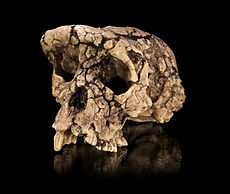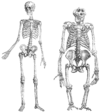Hominini
| Hominins Temporal range: 5.4–0Ma | |
|---|---|
 | |
| Skull of Sahelanthropus tchadensis, described as the earliest member of the hominin line,[1] but this is debated[2] | |
| Scientific classification | |
| Kingdom: | Animalia |
| Phylum: | Chordata |
| Class: | Mammalia |
| Order: | Primates |
| Suborder: | Haplorhini |
| Family: | Hominidae |
| Subfamily: | Homininae |
| Tribe: | Hominini Gray, 1825 |
| Type species | |
| Homo sapiens Linnaeus, 1758 | |
| Genera | |
|
Subtribe Hominina
Subtribe Australopithecina | |
The Hominini are a tribe of Homininae comprising the genus Homo and other genera of the human clade after the split from the tribe Panini (chimpanzees).[3][4] Members of the tribe are called hominins (cf Hominidae, "hominids").
The subtribe Hominina is the "human" branch, including genus Homo. Researchers proposed the taxon Hominini on the basis of the idea that the least similar species of a trichotomy should be separated from the other two. Some earlier classification schemes include the genus Pan (chimpanzees) within the Hominini, but this classification is now rarely followed. Sahelanthropus tchadensis is an extinct hominid species that lived 7 million years ago, very close to the time of the chimpanzee–human divergence; it is thus unclear whether it can be considered a member of the Hominini tribe.
A source of confusion in determining the exact age of the Pan–Homo split is evidence of a more complex speciation process rather than a clean split between the two lineages. Different chromosomes appear to have split at different times, possibly over as much as a 4-million-year period, indicating a long and drawn out speciation process with large-scale hybridization events between the two emerging lineages as late as 6.3 to 5.4 million years ago according to Patterson et al. (2006).[5] The assumption of late hybridization was in particular based on the similarity of the X chromosome in humans and chimpanzees, suggesting a divergence as late as some 4 million years ago. This conclusion was rejected as unwarranted by Wakeley (2008), who suggested alternative explanations, including selection pressure on the X chromosome in the populations ancestral to the CHLCA.[6]
Few fossil specimens on the Pan side of the split have been found, the first fossil chimpanzee discovery being published in 2005,[7] dating to between 545 ± 3 kyr (thousand years) and 284 ± 12 kyr via Argon-argon dating, from Kenya's East African Rift Valley. All of the extinct genera listed in the table to the right are ancestral to Homo, or are offshoots of such. However, both Orrorin and Sahelanthropus existed around the time of the split, and so may be ancestral to all three extant species.
In the proposal of Mann and Weiss (1996),[8] the tribe Hominini includes Pan as well as Homo, but within separate subtribes. Homo (and, by inference, all bipedal apes) is in the subtribe Hominina, while Pan is in the subtribe Panina. Wood (2010) discusses the different views of this taxonomy.[9]
See also
- History of hominoid taxonomy
- List of human evolution fossils (with images)
References
- ↑ Brunet, Michel (July 2002), "A new hominid from the Upper Miocene of Chad, Central Africa", Nature 418 (6894): 145–151, doi:10.1038/nature00879, PMID 12110880,
Sahelanthropus is the oldest and most primitive known member of the hominid clade, close to the divergence of hominids and chimpanzees.
- ↑ Wolpoff, Milford (October 2002), "Sahelanthropus or‘Sahelpithecus’?", Nature 419: 581–582, doi:10.1038/419581a,
Sahelanthropus tchadensis is an enigmatic new Miocene species, whose characteristics are a mix of those of apes and Homo erectus and which has been proclaimed by Brunet et al. to be the earliest hominid. However, we believe that features of the dentition, face and cranial base that are said to define unique links between this Toumaï specimen and the hominid clade are either not diagnostic or are consequences of biomechanical adaptations. To represent a valid clade, hominids must share unique defining features, and Sahelanthropus does not appear to have been an obligate biped.
- ↑ Bradley, B. J. (2006). "Reconstructing Phylogenies and Phenotypes: A Molecular View of Human Evolution". Journal of Anatomy 212 (4): 337–353. doi:10.1111/j.1469-7580.2007.00840.x. PMC 2409108. PMID 18380860.
- ↑ Wood and Richmond.; Richmond, BG (2000). "Human evolution: taxonomy and paleobiology". Journal of Anatomy 197 (Pt 1): 19–60. doi:10.1046/j.1469-7580.2000.19710019.x. PMC 1468107. PMID 10999270.
- ↑ Patterson N, Richter DJ, Gnerre S, Lander ES, Reich D (June 2006). "Genetic evidence for complex speciation of humans and chimpanzees". Nature 441 (7097): 1103–8. doi:10.1038/nature04789. PMID 16710306.
- ↑ Wakeley J (March 2008). "Complex speciation of humans and chimpanzees". Nature 452 (7184): E3–4; discussion E4. doi:10.1038/nature06805. PMID 18337768. "Patterson et al. suggest that the apparently short divergence time between humans and chimpanzees on the X chromosome is explained by a massive interspecific hybridization event in the ancestry of these two species. However, Patterson et al. do not statistically test their own null model of simple speciation before concluding that speciation was complex, and—even if the null model could be rejected—they do not consider other explanations of a short divergence time on the X chromosome. These include natural selection on the X chromosome in the common ancestor of humans and chimpanzees, changes in the ratio of male-to-female mutation rates over time, and less extreme versions of divergence with gene flow. I therefore believe that their claim of hybridization is unwarranted."
- ↑ McBrearty, Sally and Nina G. Jablonski (2005). "First fossil chimpanzee". Nature 437 (7055): 105–108. Bibcode:2005Natur.437..105M. doi:10.1038/nature04008. PMID 16136135.
- ↑ Mann, Alan and Mark Weiss (1996). "Hominoid Phylogeny and Taxonomy: a consideration of the molecular and Fossil Evidence in an Historical Perspective". Molecular Phylogenetics and Evolution 5 (1): 169–181. doi:10.1006/mpev.1996.0011. PMID 8673284.
- ↑ B. Wood (2010). "Reconstructing human evolution: Achievements, challenges, and opportunities". Proceedings of the National Academy of Sciences 107: 8902–8909. Bibcode:2010PNAS..107.8902W. doi:10.1073/pnas.1001649107.
| Wikispecies has information related to: Hominini |
| ||||||||||||||||||||
| ||||||||||||||||||||||||||||||||||||||||||
